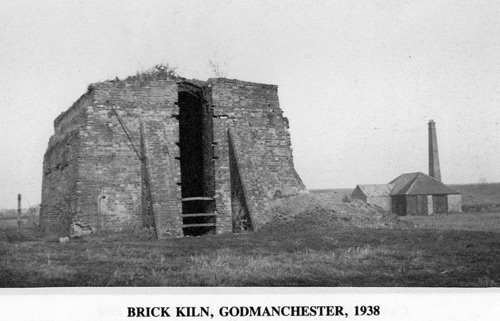The typical yellowish bricks of Godmanchester's older houses and cottages were produced in local brickworks. Brickmaking was a major activity in Godmanchester in the 19th century. There were two brickworks in Cow Lane operating from around 1830 and one was still open at the beginning of the First World War. There was at least one other documented brickworks off Cambridge Road.
Brickmaking was a major activity in Godmanchester in the 19th century. There were two brickworks in Cow Lane operating from around 1830 and one was still open at the beginning of the First World War. There was at least one other documented brickworks off Cambridge Road.
Before mechanisation, brickmaking was an arduous and sometime dangerous affair. There is a good description of the process by F W. Bird in his "Memorials of Godmanchester' (available from the Bookshop).
As a child in the 1840s he would go to the Cow Lane Works and watch the activity. The clay was dug from the ground and broken up in a mill with horses walking continually in a circle. The brick makers would work all day at the bench forcing the now pliable clay into moulds and scraping off the top. Each brick maker was attended by a boy who would load the barrows to take the bricks off to be dried in special sheds. Once sufficiently dried, the bricks were placed in a kiln for firing. The firing was a delicate process and success was very much dependent on the skill of the kiln manager. Over or under firing could render the bricks useless. Subsequently the Cow Lane brickworks were mechanised and a "Suffolk Kiln installed. The remains of the kiln could still be seen in Cow Lane until recently. (Huntingdon Records Office has a photograph.)
It is interesting to note that all the earliest brick houses in Godmanchester are all built in red bricks which were not made from the locally dug clay. These red bricks would have been carried some distance, possibly by river. The oldest brickwork is on the Queen Elizabeth School using the much thinner bricks of the late 16th century. These bricks are very similar to those used at Buckden Palace and at Hinchingbrooke.
Godmanchester's grand houses of the 18th century, Island Hall and Farm Hall, are also built in red brick. The decision to use red bricks would most probably have been taken for aesthetic reasons.
For humbler house building, there would still have been a reasonable supply of timber and it was not until the local woodland had disappeared that the manufacture of local yellow bricks for everyday building became a necessity.
Robert Beart, the Godmanchester inventor and entrepreneur lived in Cambridge Road and played an important part in the development of brickmaking. He developed and patented sophisticated production techniques for "extruding' bricks and tiles using steam engines. The techniques were extremely successful and he set up a large brick production adjacent to Huntingdon Station in about 1845. Here he produced his patented extruded yellow bricks with 24 perforations which allowed the bricks to be burnt more thoroughly and evenly and permitted the moisture to escape. His mass production techniques, using steam power enabled the clay to be ground, extruded and dried within a 24 hour cycle rather than over a number of weeks as was the case before mechanisation. Being adjacent to the railway meant that Beart could provide bricks for the huge London market. For example, "Beart's bricks' were specified for the fashionable Alexander Estate in Kensington. Beart's bricks, with the 24 holes are often seen when old walls are demolished in Godmanchester.
Graham Campbell
Chairman, Huntingdon and Godmanchester Civic Society.